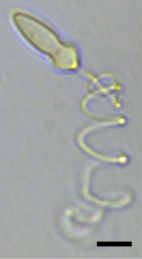Nematocyst (dinoflagellate)
A nematocyst is a subcellular structure or organelle containing extrusive filaments found in two families of athecate dinoflagellates (a group of unicellular eukaryotes), the Warnowiaceae and Polykrikaceae.[1] It is distinct from the similar subcellular structures found in the cnidocyte cells of cnidarians, a group of multicellular organisms including jellyfish and corals; such structures are also often called nematocysts (alternatively, cnidocysts or cnidae), and cnidocytes are sometimes referred to as nematocytes. It is unclear whether the relationship between dinoflagellate and cnidarian nematocysts is a case of convergent evolution or common descent, although molecular evidence has been interpreted as supporting an endosymbiotic origin for cnidarian nematocysts.[2]
In polykrikoids the nematocyst is found associated with another extrusive organelle called the taeniocyst, a complex that has been described as synapomorphic for the genus Polykrikos.[1][3]
The full range of functional roles of the nematocyst is not well understood, but it has been observed to be involved in prey capture and feeding.[2][4]
References
- ^ a b c d Hoppenrath, M; Bachvaroff, TR; Handy, SM; Delwiche, CF; Leander, BS (25 May 2009). "Molecular phylogeny of ocelloid-bearing dinoflagellates (Warnowiaceae) as inferred from SSU and LSU rDNA sequences". BMC Evolutionary Biology. 9: 116. doi:10.1186/1471-2148-9-116. PMID 19467154.
{{cite journal}}: CS1 maint: unflagged free DOI (link) - ^ a b Hwang, Jung Shan; Nagai, Satoshi; Hayakawa, Shiho; Takaku, Yasuharo; Gojibori, Takashi (2008). "The Search for the Origin of Cnidarian Nematocysts in Dinoflagellates". In Pontarotti, Pierre (ed.). Evolutionary biology from concept to application. Berlin: Springer. ISBN 978-3-540-78992-5.
- ^ Westfall, JA; Bradbury, PC; Townsend, JW (September 1983). "Ultrastructure of the dinoflagellate Polykrikos. I. Development of the nematocyst-taeniocyst complex and morphology of the site for extrusion". Journal of Cell Science. 63: 245–61. PMID 6685130.
- ^ JEONG, HAE JIN; LEE, KYUNG HA; YOO, YEONG DU; KANG, NAM SEON; LEE, KITACK (November 2011). "Feeding by the Newly Described, Nematocyst-Bearing Heterotrophic Dinoflagellate Gyrodiniellum shiwhaense". Journal of Eukaryotic Microbiology. 58 (6): 511–524. doi:10.1111/j.1550-7408.2011.00580.x.


